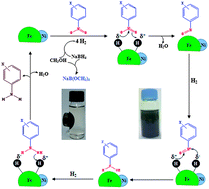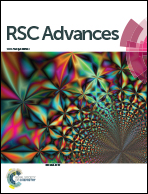Highly efficient and chemoselective transfer hydrogenation of nitroarenes at room temperature over magnetically separable Fe–Ni bimetallic nanoparticles†
Abstract
A highly chemoselective catalytic transfer hydrogenation (CTH) of nitroarenes to corresponding amino derivatives is achieved with Fe–Ni bimetallic nanoparticles (Fe–Ni NP's) as the catalyst and NaBH4 at room temperature. Their catalytic efficiency is ascribed to the presence of Ni sites on the bimetallic surface that not only hinder the surface corrosion of the iron sites but also facilitate efficient electron flow from the catalyst surface to the adsorbed nitro compounds. This facet is corroborated with reusability studies as well as surface characterization of the catalyst before and after its repetitive usage. Thus, these nanoparticles efficiently catalyze the reduction of functionalized nitroarenes to corresponding amines without use of corrosive agents like base or other additives under ambient conditions and are easily separated by a laboratory magnet in an eco-friendly manner.


 Please wait while we load your content...
Please wait while we load your content...